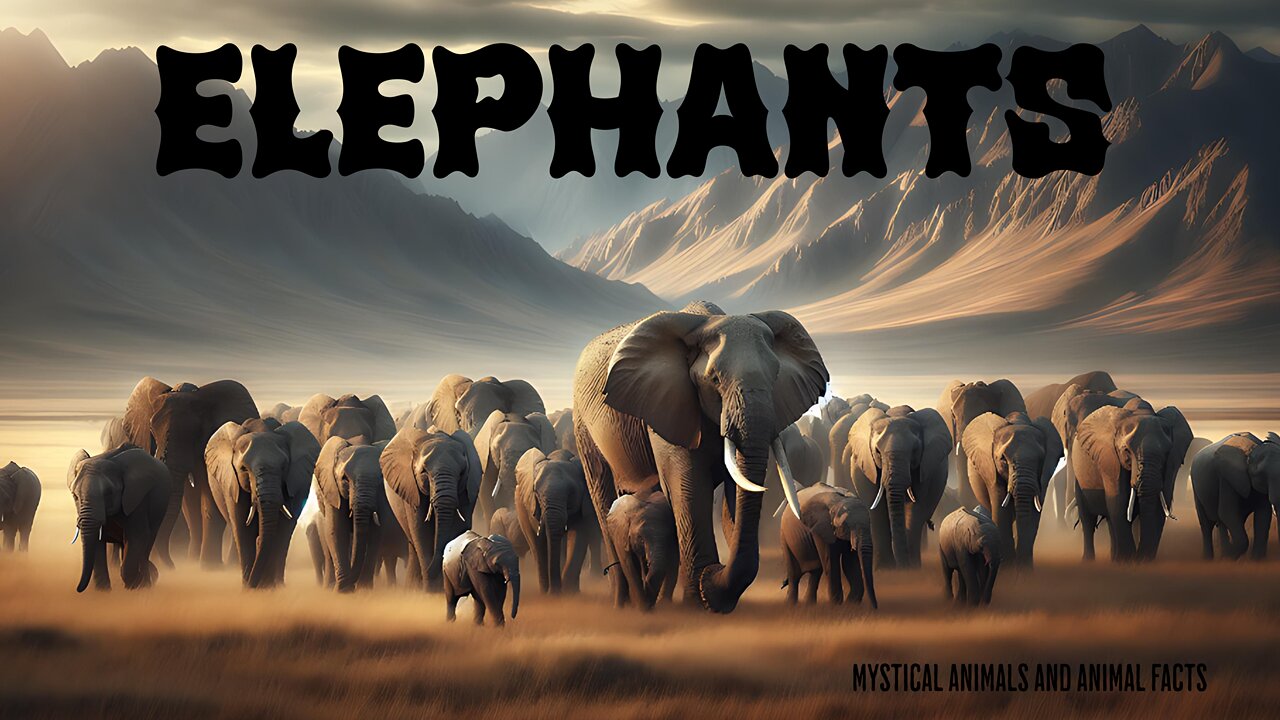Premium Only Content

Elephants: gentle giants of the animal world - Animal mini documentary
Shirts and more
Designs Redbubble
https://www.redbubble.com/people/ReneMM/shop?asc=u
Spreadshirt.at
https://www.spreadshirt.at/shop/user/renemm/?srEdit=pa#?affiliateId=1257693
Spreadshirt.com
https://www.spreadshirt.com/shop/user/renemm/?srEdit=pa#?affiliateId=11625
Shirtee.at
https://www.shirtee.com/de/catalogsearch/result/index/designer_id/112048/all_stores/
1/
Pictures
https://fineartamerica.com/profiles/rene-mitterlehner
The elephant, a mammal from the order of the proboscideans, is one of the largest and most charismatic land animals on earth, whereby three recent species are distinguished: the African savannah elephant, the African forest elephant and the Asian elephant. They are characterised by their massive build, columnar legs, grey, wrinkled skin, large ears for thermoregulation and the eponymous trunk, a muscular, elongated nasal organ with over 40,000 muscle fibres, which serves as a gripping tool, breathing organ, means of communication and drinking aid. The tusks, elongated upper jaw teeth made of ivory, are used for digging for water, debarking trees, defence and ritualised fighting among bulls. African elephants of both sexes have tusks, whereas in Asian elephants often only the males develop visible tusks. The ears of the African species are significantly larger and shaped like the continents of Africa, while Asian elephants have smaller, rounded ears and a curved back. With a shoulder height of up to 4 metres and a weight of up to 7.5 tonnes (African savannah elephant), they are among the heaviest land animals, although the forest elephant remains more compact at around 3 tonnes. Elephants are pure herbivores, consuming up to 150 kilograms of plant material a day - grasses, leaves, bark, fruits and roots - and spreading seeds through their faeces, making them key species for the conservation of ecosystems. Their digestive system is inefficient; only about 40 % of their food is utilised, which is why they have to eat for up to 18 hours a day. Elephants live in matriarchally organised herds consisting of related cows and their calves, while adult bulls usually roam solitary or in bachelor groups. The social structure is complex: individuals recognise each other by sounds that carry up to 10 kilometres and communicate via infrasound frequencies below the human hearing threshold, which are perceived as vibrations through the ground. Calves are born after a gestation period of 22 months, the longest gestation period of any land mammal, and weigh around 100 kilograms at birth. They are suckled for up to five years and remain closely attached to their mother for the rest of their lives. Elephants reach an age of 60 to 70 years in the wild, although their life expectancy is limited by tooth wear: they have six molars per jaw half, which grow back one after the other and are worn down as they grind up the fibre-rich food. The last tooth is worn out at around 40 years of age. Elephants play a central role in their habitats: By knocking down trees, they create clearings that provide space for new plant species, and their footprints create temporary microhabitats for insects and amphibians. Migration routes that are used over generations connect waterholes and feeding grounds, with older animals acting as a ‘knowledge store’ of locations in times of drought. Human-elephant conflicts arise from habitat loss as farmland and settlements encroach on traditional migration corridors; elephants devastate fields, leading to retaliatory killings. Poaching for ivory drove African elephants to the brink of extinction in the 20th century. Between 1979 and 1989, their population halved to around 600,000 individuals, with the forest elephant only being recognised as a separate species through genetic studies in 2010 and being particularly threatened by poachers. The Asian elephant, with fewer than 50,000 animals living in the wild, is endangered due to habitat fragmentation, as only 20 per cent of its historical range remains intact. Conservation measures include the establishment of corridors between protected areas, the training of anti-poaching units and the use of GPS collars to monitor herd movements. In some cultures, particularly in South and Southeast Asia, elephants have been used for thousands of years as work animals in forestry, transport and religious ceremonies; domesticated animals are trained through positive reinforcement, with ‘kraal’ capture, a traditional method of integrating wild elephants into work groups, now largely replaced by captive breeding. Elephant skins are coveted in the traditional medicine of some cultures, while ivory continues to be traded on illegal markets despite international trade bans. Modern research is investigating the cognitive abilities of elephants: they show self-awareness in the mirror test, use tools such as branches to drive away flies and mourn the death of conspecifics by touching bones or lingering for hours at the carcass. Their brain weighs up to 5 kilograms and has a highly developed neocortex area that enables complex social interactions. In ecology, elephants are regarded as ‘engineers’ of their environment: in forests they reduce tree density and thus promote biodiversity, in savannahs they prevent the scrub encroachment of grassland. Fossil finds prove that proboscideans were once a more diverse group: Over 170 extinct species, including mammoths and mastodons, once colonised every continent except Australia and Antarctica. Today's elephants are the last survivors of this lineage, with genome analyses indicating a separation of the African and Asian species 7.6 million years ago. In cultural history, elephants symbolise wisdom and strength: in Hinduism, the god Ganesha with the head of an elephant is regarded as the conqueror of obstacles, in Buddhist traditions a white elephant embodies the birth of the Buddha, and in ancient Rome war elephants were paraded in triumphal processions. Archaeological finds prove that the Indus culture used elephants as beasts of burden 4,500 years ago.
-
 LIVE
LIVE
MattMorseTV
44 minutes ago🔴Dems. MELT DOWN over LEAKED MESSAGES.🔴
5,751 watching -
 DVR
DVR
BonginoReport
2 hours agoDems Take Credit For Ceasefire, Blame Trump - Nightly Scroll w/ Hayley Caronia (Ep.155)
13K14 -
 1:11:30
1:11:30
Turning Point USA
3 hours agoCharlie Kirk Receives The Medal of Freedom at The White House | 10.14.2025
154K60 -
 LIVE
LIVE
SpartakusLIVE
38 minutes agoLIVE from SUPER SECRET, VIP Location || BEACH FRONT into Verdansk
330 watching -
 UPCOMING
UPCOMING
Mally_Mouse
7 hours ago📣Telescreen Talks - LIVE!
302 -
 1:06:24
1:06:24
TheCrucible
2 hours agoThe Extravaganza! EP: 53 with guest co-host Rob Noerr (10/14/25)
12.8K14 -
 1:31:12
1:31:12
Kim Iversen
2 hours agoMAYDAY! America’s Food System Is Collapsing — And Trump Thinks CHINA Will SAVE Us?
20.5K54 -
 LIVE
LIVE
StoneMountain64
6 hours agoBattlefield 6 Sniping and Unlocking SNIPERS from LONG RANGE
113 watching -
 LIVE
LIVE
GritsGG
52 minutes agoSolos! Most Wins in WORLD! 3734+!
89 watching -
 3:59:54
3:59:54
Right Side Broadcasting Network
6 hours agoLIVE REPLAY: President Trump Participates in the Charlie Kirk Medal of Freedom Ceremony - 10/14/25
117K33